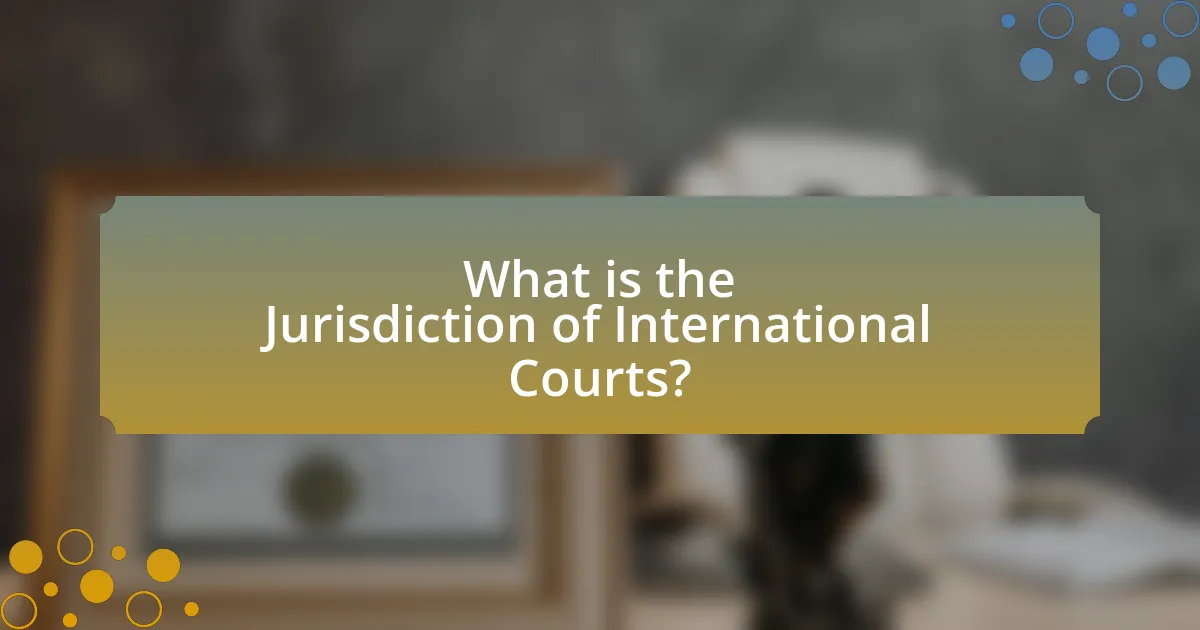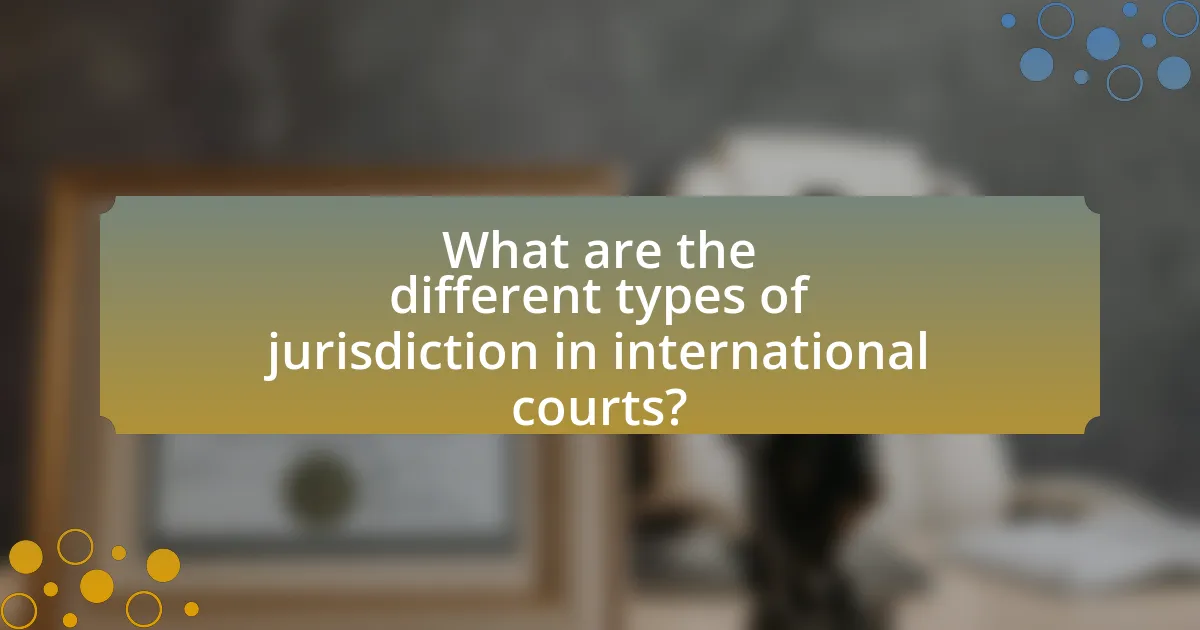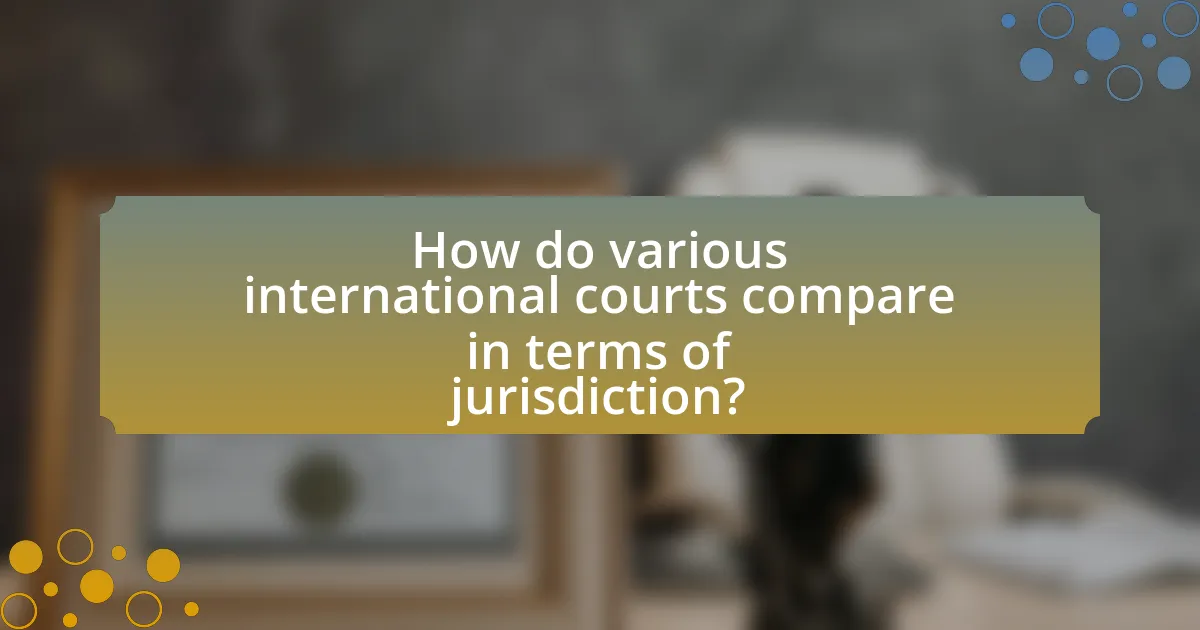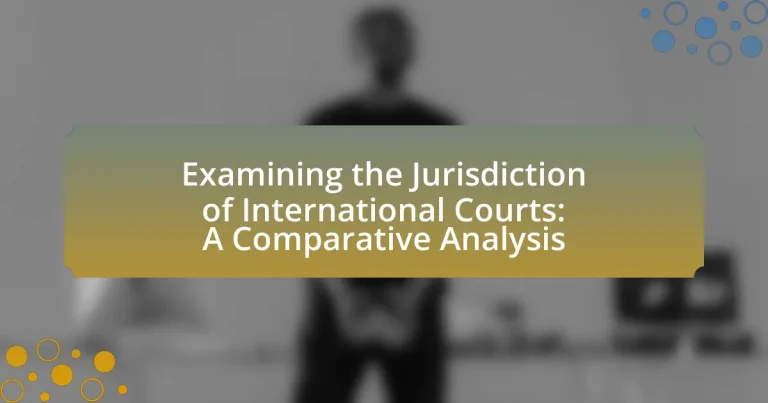The article examines the jurisdiction of international courts, focusing on their legal authority to adjudicate disputes and interpret international law. It outlines how jurisdiction is defined within international law, emphasizing key principles such as consent, territoriality, and human rights protection. The article differentiates between various types of jurisdiction, including contentious and advisory jurisdiction, and compares the mandates of different international courts, such as the International Court of Justice and the International Criminal Court. Additionally, it addresses the challenges faced by international courts regarding jurisdiction, the implications of non-compliance with rulings, and best practices for enhancing understanding of jurisdictional issues in international law.

What is the Jurisdiction of International Courts?
The jurisdiction of international courts refers to their legal authority to adjudicate disputes and interpret international law. This jurisdiction is typically defined by treaties, statutes, or agreements that establish the court’s mandate, such as the Statute of the International Court of Justice, which allows the court to hear cases involving states and provide advisory opinions on legal questions referred to it by authorized UN organs or agencies. Additionally, international courts may have jurisdiction over specific issues, such as human rights violations or war crimes, depending on their founding documents and the consent of the states involved.
How is jurisdiction defined in the context of international law?
Jurisdiction in the context of international law is defined as the authority of a state or international tribunal to make legal decisions and judgments over individuals, entities, or events. This authority is established through treaties, customary international law, and the principles of state sovereignty. For instance, the International Court of Justice (ICJ) derives its jurisdiction from the consent of states, as outlined in Article 36 of its Statute, which allows for both contentious cases and advisory opinions. This framework ensures that jurisdiction is exercised in accordance with established legal norms and the consent of the parties involved.
What are the key principles governing jurisdiction in international courts?
The key principles governing jurisdiction in international courts include consent, the principle of territoriality, and the protection of human rights. Consent is fundamental, as states must agree to submit to the court’s jurisdiction, often through treaties or specific agreements. The principle of territoriality asserts that a court has jurisdiction over events occurring within a state’s borders, as established in cases like the International Court of Justice’s ruling in the Nicaragua case. Additionally, the protection of human rights allows international courts to assert jurisdiction in cases involving violations, reflecting the global commitment to uphold human rights standards, as seen in the European Court of Human Rights’ jurisdiction over member states.
How does jurisdiction differ between various international courts?
Jurisdiction differs between various international courts primarily based on their mandates and the types of cases they are authorized to adjudicate. For instance, the International Court of Justice (ICJ) has jurisdiction over disputes between states and advisory opinions on legal questions referred by UN organs, while the International Criminal Court (ICC) focuses on prosecuting individuals for crimes such as genocide, war crimes, and crimes against humanity. Additionally, regional courts like the European Court of Human Rights (ECHR) address human rights violations within member states, emphasizing individual rights rather than state disputes. This differentiation in jurisdiction is rooted in the specific treaties and statutes that establish each court, defining their scope and authority.
Why is jurisdiction important for international courts?
Jurisdiction is crucial for international courts because it determines the authority of these courts to hear and decide cases involving states and individuals. Without clearly defined jurisdiction, international courts cannot effectively enforce laws or deliver justice, leading to a lack of accountability for violations of international law. For instance, the International Criminal Court (ICC) operates under the principle of complementarity, meaning it can only prosecute cases when national courts are unwilling or unable to do so, highlighting the importance of jurisdiction in ensuring that justice is served.
What role does jurisdiction play in the enforcement of international law?
Jurisdiction is crucial in the enforcement of international law as it determines the authority of a court or tribunal to hear a case and make binding decisions. Without established jurisdiction, international courts cannot effectively adjudicate disputes or enforce legal obligations among states. For instance, the International Court of Justice (ICJ) requires consent from states to exercise jurisdiction, which is often outlined in treaties or agreements. This principle is evident in cases like the Nicaragua v. United States, where the ICJ ruled based on its jurisdiction derived from the parties’ consent to the court’s authority. Thus, jurisdiction directly influences the capacity of international law to be applied and upheld in global governance.
How does jurisdiction impact the effectiveness of international courts?
Jurisdiction significantly impacts the effectiveness of international courts by determining the scope of cases they can adjudicate. When a court has limited jurisdiction, it may be unable to address critical issues or enforce rulings, thereby undermining its authority and effectiveness. For instance, the International Criminal Court (ICC) can only prosecute crimes committed by individuals from states that are party to the Rome Statute or have accepted its jurisdiction, which restricts its ability to address crimes in non-member states. This limitation has resulted in challenges in prosecuting high-profile cases, such as those involving leaders from countries like the United States and China, which are not ICC members. Consequently, jurisdictional constraints can lead to gaps in accountability and hinder the overall impact of international judicial mechanisms.

What are the different types of jurisdiction in international courts?
International courts operate under several types of jurisdiction, primarily including contentious jurisdiction, advisory jurisdiction, and universal jurisdiction. Contentious jurisdiction allows courts to resolve disputes between states, as seen in cases adjudicated by the International Court of Justice (ICJ). Advisory jurisdiction enables courts to provide legal opinions on questions posed by authorized entities, such as the United Nations, which the ICJ also exercises. Universal jurisdiction permits states or international courts to prosecute individuals for serious crimes, such as genocide or war crimes, regardless of where the crime was committed or the nationality of the perpetrators or victims, exemplified by the International Criminal Court’s mandate. These types of jurisdiction are foundational to the functioning of international legal systems and are supported by treaties and customary international law.
What is contentious jurisdiction?
Contentious jurisdiction refers to the authority of a court to hear and decide disputes between parties, typically involving claims of rights or obligations. This type of jurisdiction is characterized by the court’s ability to adjudicate cases where there is a disagreement between two or more parties, often requiring the court to interpret laws or treaties. For instance, in international law, contentious jurisdiction is exercised by courts such as the International Court of Justice, which resolves disputes between states based on international treaties and customary law.
How does contentious jurisdiction function in international disputes?
Contentious jurisdiction in international disputes refers to the authority of international courts to adjudicate cases brought by states against one another. This jurisdiction is typically established through treaties, such as the Statute of the International Court of Justice, which allows states to submit disputes to the court voluntarily. The functioning of contentious jurisdiction involves several key elements: the consent of the parties involved, the nature of the dispute, and the legal framework governing the court’s operations. For instance, the International Court of Justice can only hear cases if both parties consent to its jurisdiction, either through a specific agreement or by accepting the court’s jurisdiction in general terms. This principle of consent is foundational in international law, as it respects state sovereignty while providing a mechanism for peaceful resolution of disputes.
What are examples of cases involving contentious jurisdiction?
Examples of cases involving contentious jurisdiction include the International Court of Justice (ICJ) case of “Nicaragua v. United States” (1986), where Nicaragua brought a case against the U.S. for military and paramilitary activities in its territory. Another example is “Bosnia and Herzegovina v. Serbia and Montenegro” (2007), where Bosnia accused Serbia of genocide during the 1992-1995 war. These cases illustrate how states can bring disputes before international courts to resolve issues of legal rights and obligations.
What is advisory jurisdiction?
Advisory jurisdiction refers to the authority of a court to provide non-binding opinions on legal questions referred to it by authorized entities, rather than resolving disputes between parties. This type of jurisdiction is commonly exercised by international courts, such as the International Court of Justice, which can issue advisory opinions on legal matters at the request of the United Nations or its specialized agencies. The significance of advisory jurisdiction lies in its role in clarifying legal principles and guiding states and organizations in their actions, thereby contributing to the development of international law.
How does advisory jurisdiction differ from contentious jurisdiction?
Advisory jurisdiction differs from contentious jurisdiction in that advisory jurisdiction involves providing legal opinions on questions posed by authorized entities, while contentious jurisdiction addresses disputes between parties that require binding resolutions. Advisory jurisdiction, as seen in institutions like the International Court of Justice, does not involve a legal dispute but rather offers guidance on legal questions, which can influence international law. In contrast, contentious jurisdiction requires the court to adjudicate specific cases where parties seek a definitive ruling, establishing legal obligations or rights. This distinction is crucial in understanding the roles and functions of international courts in resolving legal issues.
What are the implications of advisory opinions from international courts?
Advisory opinions from international courts have significant implications for international law and state behavior. These opinions provide authoritative interpretations of legal questions, which can influence the development of international norms and guide states in their actions. For instance, the International Court of Justice (ICJ) issued an advisory opinion in 2004 regarding the legality of the construction of a wall in the Occupied Palestinian Territory, which shaped international discourse and policy on the Israeli-Palestinian conflict. Such opinions, while non-binding, carry persuasive weight and can affect the decisions of states and international organizations, as they reflect the court’s interpretation of international law. This influence is evident in how states may adjust their policies or practices in response to the legal reasoning presented in these advisory opinions, thereby reinforcing or challenging existing legal frameworks.

How do various international courts compare in terms of jurisdiction?
Various international courts differ significantly in terms of jurisdiction, primarily based on their mandates and the types of cases they can adjudicate. For instance, the International Court of Justice (ICJ) has jurisdiction over disputes between states and advisory opinions on legal questions referred by UN organs, while the International Criminal Court (ICC) focuses on prosecuting individuals for crimes such as genocide and war crimes. Additionally, regional courts like the European Court of Human Rights (ECHR) address human rights violations within member states, emphasizing individual rights rather than state disputes. This distinction in jurisdiction reflects the specific legal frameworks and treaties that establish each court’s authority, such as the ICJ’s founding statute under the UN Charter and the Rome Statute for the ICC.
What are the jurisdictional differences between the International Court of Justice and the International Criminal Court?
The International Court of Justice (ICJ) and the International Criminal Court (ICC) have distinct jurisdictions. The ICJ primarily resolves disputes between states and provides advisory opinions on legal questions referred by UN organs or specialized agencies, as established by the ICJ Statute. In contrast, the ICC prosecutes individuals for international crimes such as genocide, war crimes, and crimes against humanity, based on the Rome Statute. The ICJ’s jurisdiction is limited to state parties that consent to its authority, while the ICC can exercise jurisdiction over individuals from states that are party to the Rome Statute or when referred by the UN Security Council.
How do the mandates of these courts influence their jurisdiction?
The mandates of international courts directly shape their jurisdiction by defining the scope and limits of their authority. For instance, the International Criminal Court (ICC) operates under the Rome Statute, which specifies its jurisdiction over genocide, war crimes, and crimes against humanity, thereby restricting its focus to these serious offenses. Similarly, the International Court of Justice (ICJ) derives its jurisdiction from the United Nations Charter and its own statute, which limits its cases to disputes between states and advisory opinions on legal questions. These mandates ensure that each court functions within a specific legal framework, influencing the types of cases they can adjudicate and the legal principles they apply.
What are the procedural differences in handling jurisdictional issues?
Procedural differences in handling jurisdictional issues primarily involve variations in legal frameworks, rules of procedure, and the authority of courts across different jurisdictions. For instance, common law jurisdictions often rely on precedent and case law to determine jurisdiction, while civil law jurisdictions may follow codified statutes more strictly. Additionally, international courts, such as the International Court of Justice (ICJ) and the International Criminal Court (ICC), have distinct procedural rules governing jurisdictional challenges, including the requirement for state consent in the ICJ and the principle of complementarity in the ICC. These differences are significant as they affect how jurisdictional disputes are resolved, influencing the outcomes of international legal proceedings.
How does regional jurisdiction differ from global jurisdiction?
Regional jurisdiction refers to the legal authority exercised by courts within a specific geographic area, while global jurisdiction encompasses the legal authority of courts to address issues that transcend national boundaries. Regional jurisdiction is often limited to the laws and treaties applicable within that region, such as the European Court of Justice, which interprets EU law, whereas global jurisdiction, exemplified by the International Criminal Court, addresses crimes like genocide and war crimes that affect the international community. This distinction is crucial as it highlights the varying scopes and limitations of legal authority based on geographic and contextual factors.
What are the characteristics of regional courts like the European Court of Human Rights?
Regional courts like the European Court of Human Rights (ECHR) are characterized by their jurisdiction over human rights issues within specific geographic areas, primarily focusing on the enforcement of human rights standards established by international treaties. The ECHR, established by the European Convention on Human Rights in 1953, allows individuals, groups, and states to bring cases against member states for alleged violations of the rights enshrined in the Convention.
These courts typically operate on principles of subsidiarity, meaning they respect the primary role of national courts in protecting human rights, intervening only when national remedies have been exhausted. Additionally, regional courts often have the authority to issue binding judgments, which member states are obligated to comply with, thereby enhancing their effectiveness in promoting human rights. The ECHR, for instance, has a significant track record of influencing national laws and practices across Europe through its rulings.
Furthermore, regional courts like the ECHR are characterized by their accessibility to individuals, allowing them to seek justice directly, which is a key feature that distinguishes them from many international courts that primarily deal with state-to-state disputes. This accessibility is supported by a relatively straightforward application process, enabling a wide range of applicants to present their cases.
How do regional courts address jurisdictional challenges compared to global courts?
Regional courts address jurisdictional challenges by focusing on specific geographic and legal contexts, while global courts operate under broader international frameworks. Regional courts, such as the European Court of Human Rights, often have jurisdiction defined by treaties among member states, which allows them to address issues pertinent to those states’ legal systems and cultural contexts. In contrast, global courts like the International Court of Justice rely on universal principles of international law and the consent of states to adjudicate disputes, which can lead to more generalized rulings that may not account for regional nuances. This distinction is evident in the way regional courts can enforce decisions more effectively within their jurisdictions due to closer ties with national legal systems, whereas global courts may face challenges in enforcement due to the need for state cooperation and varying interpretations of international law.
What are the challenges faced by international courts regarding jurisdiction?
International courts face several challenges regarding jurisdiction, primarily including issues of state consent, conflicting national laws, and enforcement of rulings. State consent is crucial because many international courts, such as the International Criminal Court, can only exercise jurisdiction if the states involved agree to it, leading to limitations in cases where states refuse to cooperate. Conflicting national laws create complications when states have different legal frameworks, which can hinder the court’s ability to adjudicate effectively. Additionally, the enforcement of rulings poses a significant challenge, as international courts often lack the power to compel compliance from states, relying instead on voluntary adherence to their decisions. These factors collectively complicate the jurisdictional landscape for international courts, impacting their effectiveness and reach.
How do state sovereignty and jurisdictional claims conflict?
State sovereignty and jurisdictional claims conflict when a state’s authority to govern itself clashes with the legal authority of international courts to adjudicate matters involving that state. This conflict arises because states prioritize their independence and territorial integrity, often resisting external legal interventions that they perceive as infringing on their sovereignty. For instance, the International Criminal Court (ICC) may seek to prosecute individuals for crimes against humanity, but a state may refuse to cooperate, arguing that such actions violate its sovereign rights. Historical examples include the refusal of the United States to ratify the Rome Statute, which established the ICC, citing concerns over national sovereignty and the potential for politically motivated prosecutions. This illustrates the ongoing tension between the principles of state sovereignty and the jurisdictional reach of international legal frameworks.
What are the implications of non-compliance with jurisdictional rulings?
Non-compliance with jurisdictional rulings can lead to significant legal and diplomatic consequences. States that fail to adhere to such rulings may face sanctions, loss of credibility in international relations, and potential retaliatory measures from other states or international bodies. For instance, the International Court of Justice (ICJ) has the authority to issue binding decisions, and non-compliance can result in the court referring the matter to the United Nations Security Council, which may impose sanctions or other measures. Historical examples include the case of the United States’ non-compliance with the ICJ ruling in the Nicaragua v. United States case, which strained U.S. relations with Central American countries and affected its standing in international law.
What best practices can enhance the understanding of jurisdiction in international courts?
Best practices that can enhance the understanding of jurisdiction in international courts include the establishment of clear legal frameworks, comprehensive training for legal practitioners, and the promotion of transparency in court proceedings. Clear legal frameworks, such as the statutes of international courts, provide essential guidelines on jurisdictional matters, ensuring that all parties understand the scope and limitations of the court’s authority. Comprehensive training for legal practitioners, including judges and lawyers, equips them with the necessary knowledge of international law and jurisdictional principles, thereby improving their ability to navigate complex cases. Furthermore, promoting transparency in court proceedings, such as publishing detailed judgments and procedural rules, fosters public understanding and trust in the judicial process, allowing stakeholders to better grasp jurisdictional issues. These practices collectively contribute to a more informed and effective engagement with international courts.
How can legal practitioners effectively navigate jurisdictional issues?
Legal practitioners can effectively navigate jurisdictional issues by thoroughly understanding the applicable laws and regulations of the jurisdictions involved. This includes analyzing treaties, statutes, and case law that govern jurisdictional matters in both domestic and international contexts. For instance, the Hague Convention on Choice of Court Agreements provides a framework for determining jurisdiction in international civil and commercial disputes, which practitioners can leverage to establish the appropriate forum for their cases. Additionally, staying updated on recent judicial interpretations and rulings can enhance their ability to anticipate jurisdictional challenges and strategize accordingly.
What resources are available for further study on international court jurisdiction?
Resources available for further study on international court jurisdiction include academic journals, books, and online databases. Notable academic journals such as the “Journal of International Dispute Settlement” and “International Court of Justice Review” publish peer-reviewed articles on jurisdictional issues. Key books like “International Court of Justice: A Commentary” by Andreas von Staden and “The Law of International Courts and Tribunals” by J. G. Merrills provide in-depth analyses. Additionally, databases like Westlaw and HeinOnline offer access to legal documents and case law relevant to international court jurisdiction, facilitating comprehensive research.


